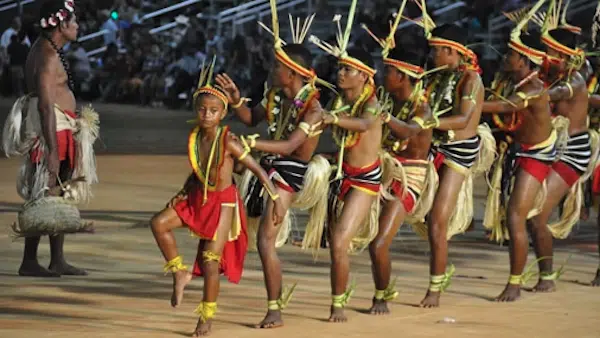More than 2,000 people are gathering in Hawaii this week and next for the 13th Festival of Pacific Island Arts and Culture. It’s the largest gathering of Indigenous Pacific peoples in the world. And it comes at a critical time for the island region known as Oceania as sea levels, storms, and other climate effects threaten traditional ways of life and connections to land and sea.
Normally the festival takes place every four years and rotates between the three regions of the Pacific: Polynesia, Micronesia, and Melanesia. But because of the pandemic, the event hasn’t happened for eight years. It was last held on Guam, and this is the first time since it was established in 1972 that it’s occurring in Hawaii. From now through June 16, Indigenous peoples from more than two dozen Pacific nations and territories will be sharing their weaving, tattoo creations, films, visual art, wood carvings, dances, songs, literature, music, food, and other expressions of Indigenous culture.
Tarcisius Kabutaulaka, a University of Hawaii professor from the Solomon Islands and former director of the university’s Center of Pacific Island Studies, said even though the focus of the festival is on performing arts, Pacific cultures are deeply interwoven with the environment.
“We produce and perform our culture vis-à-vis the environment,” said Kabutaulaka.
The baskets that we weave, the dances that we dance, are often about the environment. We use materials around us to create material culture.
That interdependency makes climate change an existential threat. In Kiribati, Kabutaulaka said, taro is a key source of food and cultural celebrations, but sea level rise and resulting saltwater intrusion into islands’ freshwater lens, is making it harder to grow the starch. Forced relocation is another ongoing problem. Just two weeks ago, Papua New Guinea was the site of a deadly landslide that buried a village. Climate change will make such extreme weather events more common, forcing villages to relocate and severing Indigenous Pacific peoples’ connection to their ancestral lands.
The festival is also happening as island nations continue to deal with the ongoing effects of colonialism. New Caledonia’s delegation pulled out at the last minute after France’s efforts to push through a referendum that would dilute Indigenous voting power prompted protests and violence.
On Friday, the festival will feature a roundtable discussion on climate change featuring political leaders from Palau and the Federated State of Micronesia. On Sunday, local activists are speaking on militarization and environmental justice, and the connections between Hawaii and Palestine.
Kabutaulaka is also helping to organize an academic event called Protecting Oceania that will include discussions of climate change, deep sea mining, mental health, and other issues. “It grapples with the idea of protection, what we are trying to protect, and how we are protecting it,” he said.
But the heart of the festival is still the arts. Vilsoni Hereniko was a student in Fiji in 1972 when the first Festival of Pacific Island Arts and Culture was held. He’s now a weaver, playwright, scholar, and a professor of cinematic arts at the University of Hawaii.
“There will always be academic conferences,” said Hereniko, who is Indigenous to Rotuma, a Polynesian island in Fiji.
But you won’t always have a hundred people from Fiji to come to Hawaii to dance the old dances and sing and chant in the ways of ancestors.
He plans to show two of his films on the coconut tree in Hawaiʻi, where the tree, beset by invasive beetles, has often been reduced to an ornament for tourists, instead of a critical source of food and nourishment. “In a way, the coconut tree without its coconut symbolizes colonization and what it’s done to the Native people,” Hereniko said.
The festival officially kicked off with an opening ceremony Thursday evening. But the day before it began with a private event on the windward side of Oʻahu, where thousands gathered to welcome crew members of voyaging canoes. Among them was the canoe Marumaru Atua, which arrived in Honolulu last weekend after sailing for 23 days from Rarotonga in the Cook Islands. The 16-person crew navigated to Hawaii using traditional knowledge of the stars and sea.
Teina Ranga is a Māori Cook Islander who is part of the Cook Islands voyaging society but flew separately to Honolulu at the last minute to join the delegation. He runs a nongovernmental organization helping young islanders reconnect with their culture through fishing and farming, and hopes the festival will continue to focus more on environmental issues moving forward.
“When do we ever have an opportunity to bring Pasifika together?” he said.
We need to push the idea of valuing who we are. The world cannot just continue [on this path]. I don’t want the Cook Islands to look like this conquering city.

